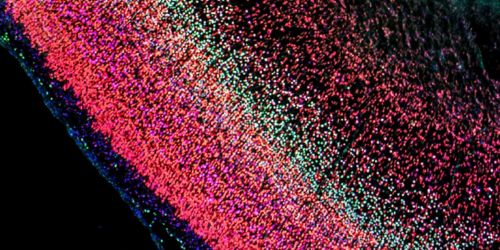St. Jude Family of Websites
Explore our cutting edge research, world-class patient care, career opportunities and more.
St. Jude Children's Research Hospital Home

- Fundraising
St. Jude Family of Websites
Explore our cutting edge research, world-class patient care, career opportunities and more.
St. Jude Children's Research Hospital Home

- Fundraising
Cell Seek provides a path to understanding the cellular origins of pediatric brain tumors

St. Jude scientists created a database to assist in the understanding of brain development. Clues to the origins of brain tumors and disorders may be found in looking at embryonic and post-birth brain development.
St. Jude researchers developed a new database, Cell Seek, which could lead to a better worldwide understanding of the cells from which certain brain cancers arise.
After conducting a study with findings published in the journal Current Biology, the team of scientists was able to create a database to assist in the basic understanding of brain development to provide a foundation for better understanding the cellular origins of brain disorders and tumors caused by abnormalities in embryonic and post-birth development.
John Easton, PhD, computational biology; Paul Northcott, PhD, developmental neurobiology; Charles Gawad, MD, PhD, oncology, and others tracked the changes in global gene expression of individual cells from a preclinical model commonly used to study development from the early embryonic period to shortly after birth.
The findings are especially relevant to pediatric patients, as most childhood brain tumors occur in the cerebellum, where the database is focused.
Brain development research database details
Investigators used the genetic sequencing technology, single-cell RNA Seq, to measure genetic activity in single cells from 12 critical times during brain development when immature cells change into specialized neurons and supporting cells.
In comparison to previous studies that have sequenced a mixture of tens of thousands of cells, this study provides a much higher resolution view of the changes the cells undergo during development. In addition, the method does not preselect cells they are going to study.
“What we have done is acquire global expression profiles of individual cells without using any prior knowledge,” Gawad said. “This allows us to study how many cell types there are at a specific developmental point and how they are related to each other in a less biased manner than previous strategies.
“If we can capture cells in these distinct developmental states, we can begin to understand pediatric diseases that occur as a result of abnormal cerebellar development.”
Cell Seek: Sharing accelerates discovery
As much as the science in the study is important, sharing its findings may turn out to be just as significant. This data is complex and more difficult to analyze than traditional RNA sequencing data – meaning labs without adequate resources would normally be unable to use this information.
“We wanted to build an easy-to-use interface that allowed labs without bioinformatics capability to mine the data," Gawad said. "With Cell Seek, they can easily track the developmental processes they are interested in and use the insights to inform their experiments to study cerebellar development and disease.”






